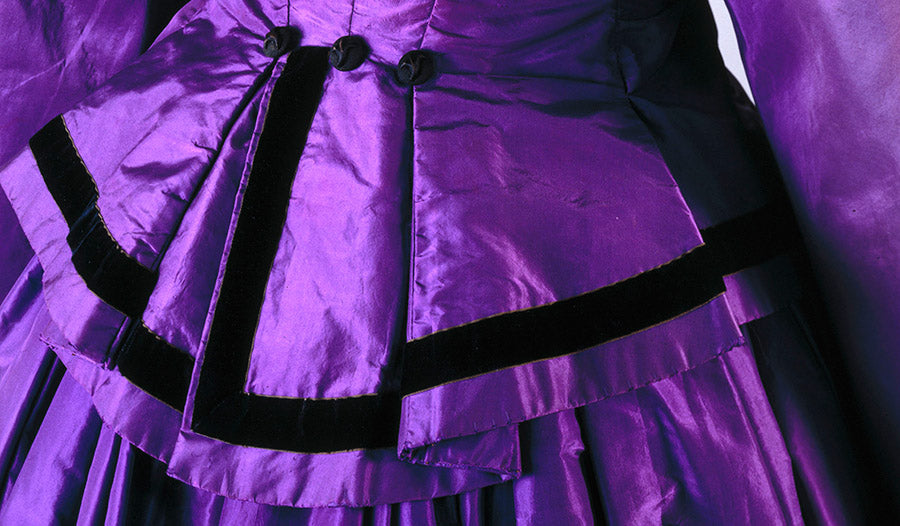
MAVERICK MAUVEINE

While 2021's Pantone colours of the year, Ultimate Gray and 'Illuminating' yellow expressed a message of positivity supported by fortitude in a year filled with yet more uncertainty — in 2022, Very Peri, 'a spritely, joyous' colour helps us 'embrace an altered landscape of possibilities opening us up to a new vision as we rewrite our lives'. On that message of dynamism and courageous creativity we take a look back at the article "Maverick Mauveine" from Issue 45 Ingenuity. Read the full pdf here.
Autumn 1857 and London broke out in a rash. The rich reds and golds of the season that shimmered prettily adding welcome decoration to the dull blacks and greys of the city streets were suddenly rivalled by a strident new shade.
First glimpsed by Queen Victoria at the flamboyant court of Napoleon III and the Empress Eugénie, she claimed the regal shade for herself, wearing it to spectacular effect at the wedding of her daughter, Victoria the Princess Royal when she married Prince Frederick William of Prussia in January 1858. The Illustrated London News reported that ‘the train and body of her majesty’s dress was composed of rich mauve (lilac) velvet trimmed with three rows of lace’ and thereby ‘Mauve Mania’ was born.

Image: Science and Society Picture Library/SSPL/SSPL via Getty images
The colour purple was nothing new in royal circles, but the vibrancy of aniline purple put the original in the shade. First recorded in c. 1500 BC, legend has it that the natural purple dye, ‘Tyrian purple’ was discovered when Hercules and his sheep dog were walking along the beach at Tyre. The dog bit into a mollusc which coloured his mouth the deep crimson of coagulated blood. Presumably it also stained his fur and the Murex Brandaris mollusc became the most prized dye for the next three millennia. Its colour was used to denote rank and reserved by Caesar for the exclusive use of the emperor and his family. Not that many could afford it - even a simple toga required 20,000 molluscs to be crushed and boiled for 10 days.
When artificial purple arrived it was a fashion revolution – but it all happened by accident. Eighteen-year-old William Perkin was experimenting in his makeshift chemistry lab at home. One of the youngest students to be accepted into the Royal College of Chemistry, he was delighted by chemistry and utterly inspired by his charismatic professor, August Wilhelm von Hofmann. Perkin’s intention was to synthesise quinine, a holiday assignment set by Hofmann: but instead of the lifesaving treatment for malaria, all Perkin had managed to produce was a beaker of black sludge. As he was rinsing the beaker with alcohol he found that the liquid turned an interesting shade of mauve and his curiosity was piqued.

Image: Piece of silk dyed by Sir William Perkin. Photograph by Richard Strauss.
Knowing that his professor would disapprove, he turned to his friend and co-pupil Arthur Church to help in his experiments to create a purple dye. There was a schism across the class divide between ‘legitimate’ scientists and those willing to use their discoveries in industry, and there was a significant risk that if Perkin failed on the ‘trade’ side of the equation his scientific career would be over before it even began.
Wary, yet determined to make the most of his strange finding, Perkin contacted dye manufacturers. He received an encouraging reply from Robert Pullar in Perth: ‘if your discovery doesn’t make the goods too expensive, it is decidedly one of the most valuable that has come out for a very long time.’ Perkin took out a patent in August 1856.
 Image: Silk dress coloured with synthetic dyes belonging to the methyl violet and aniline blue families of dyes, Britain, about 1873. Courtesy V&A Museum.
Image: Silk dress coloured with synthetic dyes belonging to the methyl violet and aniline blue families of dyes, Britain, about 1873. Courtesy V&A Museum.
With admirable faith in his son, Perkin senior – a successful builder and developer – provided the funding and started building work on a site next to the Black Horse pub on banks of the Grand Union canal in Greenford London. It wasn’t long before brother Thomas Dix Perkin gave up his architecture course to help, making it a family firm. The business quickly became profitable, not least because the coal tar from which the colour derived was an ever abundant waste product from many branches of industry.
Production levels in the textile industry were increasing at unprecedented rates in the 1850s. The only constraint was their reliance on natural dyes which were expensive due to the rarity and time consuming nature of processing them – even then the results were often not colourfast and prone to fading in sunlight. The industry was crying out for a reliable artificial alternative, and as the chemist CJT Cronshaw told the scientists assembled for the jubilee celebrations of Perkin’s discovery ‘If a fairygodmother had given Perkin the chance of choosing the precise moment for his discovery, he could not have selected a more appropriate or auspicious time’...
Extract from the article Maverick Mauveine: How William Perkin created a purple craze, written by Sarah Jane Downing in Issue 45 Ingenuity.
-
Read the rest of the article as a pdf here.

